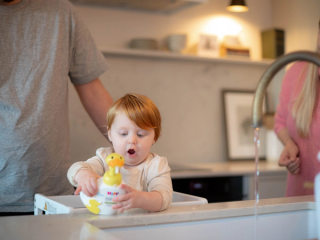
- Home
- Advice Hub
- Toddler
- Health Concerns
- Common Toddler Sleep Challenges
Common toddler sleep challenges
Our Sleep Expert, Laura, shares some of the most common sleep issues that arise with toddlers and her top tips for overcoming them.
You might have expected to experience sleepless nights when your child was a baby, but you probably thought it would be easier by the time they reach toddlerhood. Sadly, it’s not necessarily the case. Many people experience challenges with their toddler’s sleep. Here are some of the most common sleep issues that arise with toddlers and some tips for overcoming them.
Bedtime stalling
Bedtimes can become a real struggle when your child reaches toddler years as they start to exert their own free will! The thing to remember is your toddler has very little control over what happens during their day and they do need to feel a sense of autonomy. Here are my top tips for this:
- Offer your toddler choices during their routine. Make this a choice of just two things, for example ‘Would you like the blue or green towel?’ ‘Time to get into bed, are you going to hop like a kangaroo or slither like a snake!?’ Offering choices gives your toddler some age-appropriate control over what is happening. Be careful not to offer too many choices as this can become over whelming.
- Create a bedtime chart – Ideally create this with your toddler’s involvement. It could be photos of your child carrying out each task (brushing teeth, in their PJs etc..) , hand drawings, or clip art printed out. You can make the chart interactive in a number of ways, for example using Velcro and having your child pull each picture off once complete and posting it in a box!
- Make it fun! Sometime we need to find new and novel ideas to get our toddlers on board with the routine again. We have hidden a stuffed animal with the bedtime story, lined bath toys along the bath to push in and had ‘getting dry’ songs to name a few ideas!
- Use a timer to show when each activity will end. That way it’s not you saying it’s time to get out of the bath – it’s the timer!
- Hold your boundaries, set clear expectations around what will happen and stick to these. If it’s two stories, it’s two stories … every night.
- Have a sleep time ritual – toddlers and pre-schoolers often like to tell you all about their day right when they should be going to sleep. Make this part of your sleep- time ritual, but with boundaries! ‘Tell me three things about your day’ – after that simply say ‘I can’t wait to hear all about that in the morning’
- Pre-empt requests – If you know your toddler will ask for a drink, the toilet, a tissue at bedtime make sure you cover this all off as part of your routine. If hunger is a stalling tactic for your child try these bedtime snack ideas.
Bedtime snacks
If your toddler likes to ask for food once they are in bed, build a snack into your routine but make sure they understand that this is their opportunity to eat and after that they need to wait until morning. When choosing what to offer, avoid sugar and opt for high protein and whole grains. For example:
- Nut butter on whole grain toast – carbohydrates high in glycaemic index can aid sleep as they boost tryptophan and serotonin, two hormones involved in sleep. Nuts contain melatonin and magnesium, which aid sleep.
- Porridge – Oats contain tryptophan, which helps the body create serotonin needed to relax before sleep.
- Bananas – contain tryptophan, which has a role in producing melatonin helping regulate sleep pattern, as well as potassium and magnesium, which act as muscle relaxants.
Bedtime fears
From around age 3 toddlers develop a vivid imagination and sometimes this can go into overdrive and cause problems at bedtime.
- ‘Scared of the dark’ – until your child is able to actually express a fear of the dark they are very unlikely to be! If they do start asking for lights, opt for a dim red light as this will not disrupt the sleep hormones. You can get lights where the colours can be dimmed so try allowing your toddler to have it bright to begin with and dim it a little each night.
- ‘Leave the door open’ – If your child suddenly wants their door open you may be worried they will be disturbed! Try making sure the windows on the landing are blacked out and place the white noise machine in the doorway to buffer noises from downstairs. Next, work with your toddler to build their confidence having the door closed again. They could choose a stuffed toy to ‘guard’ the door each night and you can pull it closed a little more every few nights.
- ‘Stay with me!’- If your toddler was previously falling asleep independently, this can be frustrating. Decide an approach to reassure your child with a plan to move yourself out again! This might look like sitting in a different position each night and gradually moving closer to the door or proactively checking in on your toddler as they fall asleep, letting them know you will be back soon and offering lots of praise as you build their confidence back up.
Cot climbing
As your toddler gets more mobile they may start to explore their cot more and maybe even start trying to climb. I recommend you try to keep your child in their cot until as close to their third birthday as possible, so if they are climbing here are some things to try:
- Make sure the cot is on its lowest setting.
- Put your toddler in a sleeping bag to limit their ability to climb.
- Remove anything that could be aiding their climb and giving them a foot up!
- Consider the position of other furniture around the cot they could be using to climb onto.
- Assess timings and whether your toddler is under or over tired at bedtime.
Night terrors or nightmares
A night terror will usually occur during the first half of sleep, around 2-3 hours after first falling asleep. It can happen from around 18 months but tends to peak from age 5- – 7 and is more common in boys. Your child will not remember this episode in the morning as they are actually still asleep. They may scream out, thrash about, or cry inconsolably. Night terrors can be triggered by a full bladder, so try watching your child’s liquid intake in the evenings and encourage emptying their bladder before bed.
Another major cause is over tiredness so keep an eye on bedtime and try adjusting this if needed. If your child is experiencing night terrors, don’t try to wake them up and avoid touching them as this can cause distress. Stay with your child and gently shush or stroke if they will allow you to until it passes.
A nightmare is slightly different because your child will wake fully., These more commonly happen during the second half of the night during deep sleep. Night mares are common for both boys and girls around ages 3-6 years as they develop a rich imagination. Unlike a night terror you will be able to comfort your child and they will remember the episode in the morning. The causes of night mares are similar to night terrors so offer a toilet trip before bed and keep an eye on over tiredness. Also try to avoid frightening stories or TV shows before bed.
Whatever sleep challenges you are facing with your toddler you don’t have to continue to struggle through, there is support and advice out there if you feel you would benefit from more personalised guidance.



